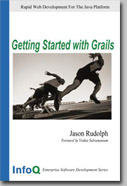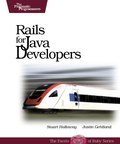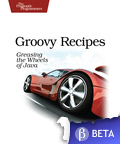Reviews: Getting Started with Grails, Rails for Java Developers and Groovy Recipes
Two weeks ago, I mentioned a number of books I was hoping to read to get up to speed on Rails and Grails quickly. Over the last two weeks, I was able to polish off three of these (listed in order of reading):
Below are short reviews of each book.
Getting Started with Grails
 The Good:
This is the perfect book to learn the basics of Grails quickly. At 133 pages, I was able to read this entire book in one sitting. The first couple chapters are very introductory, but likely necessary for beginners. The good news is you start writing your first Grails application on page 7 (Chapter 3).
The Good:
This is the perfect book to learn the basics of Grails quickly. At 133 pages, I was able to read this entire book in one sitting. The first couple chapters are very introductory, but likely necessary for beginners. The good news is you start writing your first Grails application on page 7 (Chapter 3).
Chapter 4 (Improving the User Experience) is good in that it shows you how to do warning, error and confirmation messages. This is something often overlooked in web frameworks and Rails and its "flash" concept seem to have made it important again. I remember way back in 2003 when I complained about frameworks not allowing messages to live through a redirect - everyone said it was something you didn't need. Now it's a standard part of most web frameworks.
The Bad: Uses Grails 0.3.1. This is understandable since the book was written in 2006 and published in 2007. Also, it doesn't cover testing that much (5 pages). If testing is so easy with Groovy and if Grails has Canoo WebTest support built-in, it should be shown IMO.
Rails for Java Developers
 The Good:
This was an interesting book for me because it uses AppFuse for many of its Java-based examples. Unfortunately, it uses the Struts 1.x version which is cumbersome and verbose as far as Java web frameworks go. The most impressive part of this book is how Justin and Stu do an excellent job of walking the line and not insulting Java nor developers using it. They provide an easy to understand view of Rails from a Java Developer's perspective. There's detailed chapters on ActiveRecord (as it compares to Hibernate), ActiveController (compared to Struts) and ActiveView (compared to JSP). This book has excellent chapters on Testing, Automating the Development Process and Security.
The Good:
This was an interesting book for me because it uses AppFuse for many of its Java-based examples. Unfortunately, it uses the Struts 1.x version which is cumbersome and verbose as far as Java web frameworks go. The most impressive part of this book is how Justin and Stu do an excellent job of walking the line and not insulting Java nor developers using it. They provide an easy to understand view of Rails from a Java Developer's perspective. There's detailed chapters on ActiveRecord (as it compares to Hibernate), ActiveController (compared to Struts) and ActiveView (compared to JSP). This book has excellent chapters on Testing, Automating the Development Process and Security.
The Bad: This book was published over a year ago, so it uses an older version of Rails. This means some commands don't work if you're using Rails 2.0. It's also a little light on Ruby, so I didn't feel I learned as much about the language as I was hoping to. That's understandable as it's more of a Rails book than a Ruby book.
Groovy Recipes (Beta from Jan 3, 2008)
 The Good:
I really like the style of this book and that it shows you how to get things done quickly with code samples. It's very no-nonsense in the fact that it contains a lot of code and howtos. I really like Scott's writing style and found this book the easiest to read of the three. This may have something to do with my eagerness to learn Groovy more than anything. The most refreshing part about this book is how up-to-date it is. Because it's a Beta, it seems to contain the most up-to-date information on Groovy and Grails. After reading Getting Started with Grails and working with it for a couple weeks, the first Grails chapter seemed a little basic - but that's likely because I've figured out how to mix all those recipes already. The Grails and Web Services chapter definitely has some interesting content, but I've rarely had a need to implement these recipes in a real-world environment. I'd rather see recipes on testing the UI (with the WebTest plugin) and how to use GWT and Flex with Grails. If SOUIs are the way of the feature, this is a must.
The Good:
I really like the style of this book and that it shows you how to get things done quickly with code samples. It's very no-nonsense in the fact that it contains a lot of code and howtos. I really like Scott's writing style and found this book the easiest to read of the three. This may have something to do with my eagerness to learn Groovy more than anything. The most refreshing part about this book is how up-to-date it is. Because it's a Beta, it seems to contain the most up-to-date information on Groovy and Grails. After reading Getting Started with Grails and working with it for a couple weeks, the first Grails chapter seemed a little basic - but that's likely because I've figured out how to mix all those recipes already. The Grails and Web Services chapter definitely has some interesting content, but I've rarely had a need to implement these recipes in a real-world environment. I'd rather see recipes on testing the UI (with the WebTest plugin) and how to use GWT and Flex with Grails. If SOUIs are the way of the feature, this is a must.
The Bad: Not much information on testing with GroovyTestCase, mock objects or implementing Security. If one of Groovy's sweet spots is testing, why isn't there more coverage on this topic? The Java and Groovy integration chapter is especially good, but there's very limited information on Ant and Maven. It's likely the websites provide sufficient documentation, but the Maven section only fills 5 lines on an otherwise blank page. The biggest problem I have with this book is I really like the recipes writing style and would love to see more tips and tricks. At 250 pages, I was able to finish this book with pleasure in a few days.
What's Next?
Now I'm reading JRuby on Rails (Apress) and Programming Groovy (Pragmatic Programmers). Following that, I'll be perusing dead-tree versions of Struts 2 Web 2.0 Projects (Apress), Prototype and script.aculo.us (Pragmatics) and Laszlo in Action (Manning). If any publishers want to send me books on GWT and Flex, I'd be happy to add them to my list. 


Posted by Donal on February 09, 2008 at 08:26 PM MST #
Posted by blah on February 09, 2008 at 10:39 PM MST #
Posted by Matt Raible on February 10, 2008 at 12:21 AM MST #
Posted by blah on February 10, 2008 at 02:44 AM MST #
Posted by blah on February 10, 2008 at 04:01 AM MST #
Posted by Hussein Baghdadi on February 10, 2008 at 11:30 AM MST #
Posted by Matt Raible on February 10, 2008 at 07:36 PM MST #
Posted by Hussein Baghdadi on February 11, 2008 at 06:53 AM MST #
Posted by Matt Raible on February 12, 2008 at 12:54 AM MST #
Posted by Hussein Baghdadi on February 12, 2008 at 07:06 AM MST #